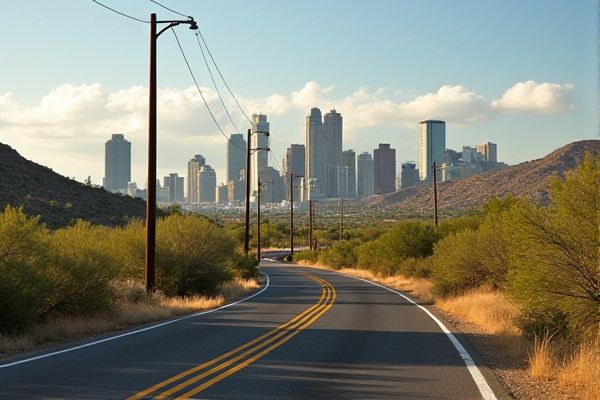
Weather and climate in Arizona: Hot desert climate. Mild winters. Summer monsoon season. Flash flood risk. Dust storms. Extreme heat advisories. Low humidity. Year-round sunshine. Altitude affects temperature. Snow in higher elevations.
Hot desert climate.
Arizona's hot desert climate is known for its intense sun exposure, boasting over 300 days of sunshine each year. The low elevation deserts in the region absorb and retain heat, exacerbating the warmth experienced by residents and visitors alike. Moreover, the urban heat island effect contributes to the rising temperatures in its cities. The climate is further influenced by the monsoon season, which introduces moisture that paradoxically makes temperatures feel even warmer. Additionally, the limited vegetation and scarcity of water restrict the natural cooling mechanisms typically found in other regions. For an in-depth understanding of this phenomenon, you can explore more about the Science Behind Why Arizona Is So Hot and discover the comprehensive insights into Arizona's unique climate conditions.
Mild winters.
Arizona's mild winters are characterized by daytime temperatures often in the lower 60s to 70s°F, while nighttime temperatures can drop slightly below freezing in the desert regions, and significantly colder in higher elevations like Alpine and Greer, where winter nights frequently drop into the 20s. In the Basin and Range region, including Phoenix, January days have a mean maximum temperature of 65°F (18°C) with occasional light frosts. For more detailed information on Arizona's climate, you can visit the Arizona Climate website.
Summer monsoon season.
Arizona's summer monsoon season, running from June 15 to September 30, is characterized by thunderstorms that bring lightning, strong winds, heavy rains, and potential dangers such as flash flooding and dust storms. Additionally, this season poses heat-related health risks due to the hot summer temperatures. For more detailed information on Arizona's weather patterns, you can visit the official Arizona Department of Water Resources website.
Flash flood risk.
Flash floods in Arizona are a significant risk, particularly during the monsoon season, characterized by sudden and localized rainfall that can turn dry washes and creeks into raging torrents. This natural hazard poses deadly threats to people and infrastructure, often resulting in severe damage and loss of life. For more information on these natural hazards, the Arizona Geological Survey provides crucial insights and resources to help communities better understand and prepare for such events.
Dust storms.
Dust storms in Arizona, known as haboobs, are massive wind storms that carry desert sand, often associated with monsoon seasons in July and August. They are caused by far-off thunderstorms creating downbursts that pick up momentum, leading to low visibility, potential flash flooding, and hazardous driving conditions. For more detailed insights on these dramatic weather events, you can visit the Phoenix New Times, a comprehensive resource on the phenomenon and its impacts.
Extreme heat advisories.
In Arizona, Extreme Heat Warnings are issued by the National Weather Service when there is a high or very high risk of heat-related illness, based on the HeatRisk forecast tool. These warnings are triggered when temperatures are expected to be unusually hot, even by local standards, and are intended to raise awareness and prevent heat illness and death, with alerts varying in severity from Excessive Heat Watches to Excessive Heat Warnings depending on the forecast confidence.
Low humidity.
Arizona is characterized by low humidity, with annual average humidity values ranging from 55% at Flagstaff to around 33% at Yuma, and summer humidity levels often below 20%, exacerbated by high temperatures and extensive sunshine. This dry climate leads to various challenges, including dry skin, respiratory issues, and the need for humidification in homes to maintain comfort and health. For more detailed information on Arizona's climate, the Western Regional Climate Center provides comprehensive insights and data.
Year-round sunshine.
Arizona is known for its abundant year-round sunshine, with cities like Phoenix averaging 211 sunny days and Yuma leading as the "Sunniest City on Earth" with 242 sunny days per year, and both cities experiencing over 85% of daylight hours with sunshine.
Altitude affects temperature.
The significant temperature differences in Arizona are largely due to variations in elevation, with cities like Phoenix (at 1,086 feet) experiencing much higher temperatures than Flagstaff (at 6,909 feet), highlighting a 5,823-foot elevation difference that results in distinct climate conditions.
Snow in higher elevations.
In Arizona, snow primarily falls in higher elevations, with the San Francisco Peaks and the White Mountains receiving significant snow accumulation that contributes to the state's water resources. Places like Flagstaff and the Arizona Snowbowl can receive substantial snowfall, with Flagstaff averaging around 90 inches of snow per year.
